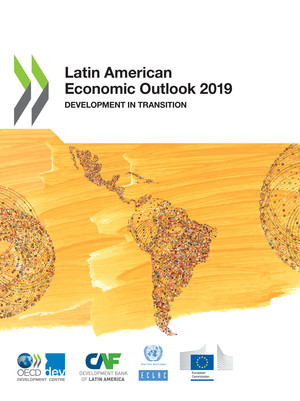copy the linklink copied! Chile
Recent trends
Chile’s record in improving development outcomes has been strong in the past decades. In particular, the share of the population living on less than USD 5.5 a day (2011 PPP) sharply decreased between 2003-15 from 29.8% to 10.1%. At the same time, the share of the population living on USD 5.5-13 a day (2011 PPP) decreased from 39.5% to 35.8%. Chile’s health indicators are now in line with the OECD average, with life expectancy at 79.5 years, infant mortality rate at 6.3 per 1 000 live births and maternal mortality ratio at 22 per 100 000 live births.
Chile’s gross domestic product (GDP) per capita increased by two-and-a-half times between 1990 and 2017. Only the Dominican Republic and Panama come close to matching this performance. Additionally, Chile’s GDP performance has been among the most stable in the region. However, labour productivity, measured in terms of GDP per person employed, stands at only 57.8% of the OECD average. Furthermore, total factor productivity growth has remained negative over 2000-17, with an average of -1%. Chile still faces some challenges in terms of education, income inequality and confidence in institutions.
National strategies and international co-operation for development
Chile has developed the National Development Plan “Construyamos tiempos mejores para Chile” [Let’s Build Better Times for Chile] 2018-22 to build national capacities and address remaining development challenges. The plan centres on four principles: freedom, justice, progress and solidarity. It prioritises Sustainable Development Goal (SDG) 9 (industry, innovation and infrastructure) and SDG 16 (peace, justice and strong institutions) (ECLAC, 2018). The first objective focuses mainly on creating quality jobs, improving education as a pillar of economic growth and advancing the technological revolution. In this way, it will allow further progress in science, innovation and entrepreneurship to increase productivity. The plan also focuses on improving governance through promoting republican institutions, citizen security, justice and human rights, modernisation of the state, decentralisation and regionalisation of power, defence and external relations.
The Development Plan proposes protecting the vulnerable and the middle class, overcoming poverty, and promoting positive ageing and decent pensions, a healthy work-life balance, improved gender equality, and policies for migratory and indigenous people as its main line of work. Chile adopted a Multidimensional Poverty Index (MPI) in December 2014 to assess and address poverty, vulnerability and inequality. The MPI, based on the National Socio-economic Characterisation Survey (CASEN in Spanish), is updated periodically.
In terms of public financing capacities, Chile’s total tax revenues were 20.4% of GDP in 2016 (vs. 22.7% in LAC and 34.3% in the OECD). The country is a pioneer in the practice of e-invoicing to improve tax revenues and fight evasion, which enables the country to collect resources for development. The country is also a signatory of the Multilateral Competent Authority Agreement on Automatic Exchange of Financial Account Information to fight tax evasion and of the Multilateral Competent Authority Agreement on Exchange of Country-by-Country Reports.
At the same time, international co-operation is also playing a role in Chile’s development process through both Triangular and South-South development co-operation. This work is led by the Chilean Agency for International Co-operation and Development (AGCID in Spanish). The agency, known formerly as the Chilean International Co-operation Agency, was renamed in March 2018 to underpin its developmental focus. The three main objectives in AGCID’s 2015-18 strategy include progress towards inclusive and sustainable development; strengthened partnerships for shared development to incorporate new actors; and the consolidation of the National System for International Co-operation and Development, as well as of the agency.
Chile is playing a double role as both recipient and donor of international co-operation. At the national level, following democratic consolidation in the 1990s, the country has been targeting structural gaps, such as climate change mitigation, environment and social development, mainly with support of the World Bank. Most recently, Chile has developed South-South Triangular Co-operation projects in partnership with Germany, El Salvador, Brazil, Spain, Japan, Sweden, Switzerland and the European Union. These projects, directed to other Latin American countries, mainly focus on agriculture, governance and social development. Additionally, South-South co-operation mostly takes place with Argentina and Mexico. Projects include energy efficiency co-operation between Salta (ARG) and Antofagosta (CHL), exchanges of technical advice on health services between Jujuy (ARG) and Antofagosta (CHL) and collaboration on waste management between Aysen (CHL) and Mexico, D.F. (MEX).
Metadata, Legal and Rights
https://doi.org/10.1787/g2g9ff18-en
© OECD/UNITED NATIONS/CAF/EU 2019
The use of this work, whether digital or print, is governed by the Terms and Conditions to be found at http://www.oecd.org/termsandconditions.


